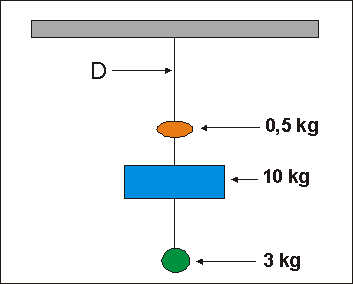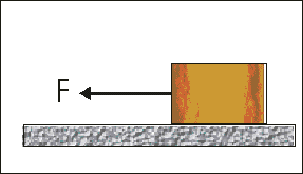Newton's Laws 1
- The acceleration of an object which is free to fall in a vacuum is ...
(A) equal to the product of force and mass.
(B) proportional to the mass of the object.
(C) independent to the mass of the object.
(D) proportional to the inverse of the mass of the object.Correct = C
There is no air resistance (frictional forces) acting on falling bodies in a vacuum. As a result a light body (for instance a feather) and a heavy body (for instance a coin) would fall with the same acceleration, hence the acceleration is independent of the mass of a body in a vavuum.
- Two asteroids, which are \(10000\; \text {km}\) apart, attract each other with a gravitational force of \(F.\) If the two asteroids move away from each other to a distance of \(20000\; \text {km}\) apart, how great will the gravitational force be?
(A) \(1/4\; F\)
(B) \(1/2\; F\)
(C) \(2\; F\)
(D) \(4 \;F\)Correct = A
\(\text{Gravitational Force} = \text{km}_1 · \text m^2/r^2.\) If distance is doubled the term under the division line becomes \(1/4 (1/2 \times 1/2 = 1/4).\) As a result, the gravitational force between the asteriods becomes a \(1/4\) of its original value.
- A girl and a boy pull in opposite directions on strings attached to each end of a spring balance. Each child exerts a force of \(20\; \text N.\) What will the reading on the spring balance be?
(A) \(0\; \text N\)
(B) \(10\; \text N\)
(C) \(20\; \text N \)
(D) \(40\; \text N\)Correct = C
Application of Newton 3: actio = reactio, accordungly the spring balance will measure \(20\; \text N.\)
- A person standing on a scaffold lowers an object of weight \(250\; \text N\) by means of a rope, at constant speed. If the weight of the rope is negligible, the force that the person exerts is …
(A) constant and less than \(250\; \text N\)
(B) equal to \(250\; \text N\)
(C) less than \(250\; \text N\) and decreasing
(D) greater than \(250\; \text N\)Correct = B
No acceleration, hence \(F = ma\) is zero. The only acting force on the bucket is the force of gravity (weight) which equals \(250\; \text N.\)
- When an apple falls from a tree, it drops to the ground because of the gravitational force between the apple and earth. \(F_1\) is the magnitude of the force exerted by the earth on the apple and \(F_2\) is the magnitude of the force exerted by the apple on the earth, then ...
(A) they have equal inertia.
(B) \(F_1\) is greater than \(F_2.\)
(C) \(F_1\) is smaller than \(F_2.\)
(D) \(F_1\) and \(F_2\) are equal.Correct = D
Again Newton 3: if a body \(A\) exerts a force \(F\) on a body \(B,\) then body \(B\) exerts an equal but opposite force on body \(A.\) Only in option D the forces are equal (in magnitude is missing).
- An astronaut picks up a stone on the moon and finds its mass to be \(2\; \text{kg}.\) If the mass of the earth is 6 times more than the mass of the moon, what will the mass and the weight of the stone be on the earth?
Answer Mass Weight (A) \(2\; \text{kg}\) \(12\; \text N\) (B) \(2 \; \text{kg}\) \(20\; \text N\) (C) \(12\; \text {kg}\) \(120\; \text N\) (D) \(20\; \text{kg}\) \(200\; \text N\) Correct = B
Mass stays the same wherever you are, \(2\; \text{kg}\) on the moon will be \(2\; \text{kg}\) on the earth. However the force of gravity on earth is stronger, \(2\; \text{kg}\) will experience a gravitational pull of \(20\; \text N,\) hence option B.
- Three objects of masses \(0.5\; \text {kg},\) \(10\; \text {kg}\) and \(3\; \text {kg}\) are suspended by a light rope as shown in the diagram below. What is the magnitude of the force acting in the rope at point \(D\)?

(A) \(13.5\; \text N \)
(B) \(18\; \text N\)
(C) \(130\; \text N\)
(D) \(135\; \text N\)Correct = D
At point \(D\) the weight of all objects is acting: \(\text{weight} = \text {mass (kg)} \times 10 \text{(N/kg)} = 13.5 \times 10 = 135\; \text N.\)
- An object is suspended from a spring balance in a lift. The reading of the balance is \(200\; \text N\) when the lift is at rest. If the balance reading is \(190\; \text N,\) the lift is moving ...
(A) downward at constant speed.
(B) downward and increasing in speed.
(C) upwards at constant speed.
(D) downward and decreasing in speed.Correct = B
At rest the object weighs \(200\; \text N,\) the weight decreases by \(10\; \text N\) due to acceleration \((F = ma),\) only on accelerating downwards (option B) the weight decreases.
- The sketch shows a block of wood being dragged across a rough horizontal surface at a constant speed by a force \(F.\) The magnitude of the frictional force between the block and the surface is …

(A) zero
(B) equal to \(F\)
(C) less than \(F\)
(D) greater than \(F\)Correct = B
Block is moving at constant speed hence acceleration is zero. Zero acceleration means frictional force is equal to pulling (or applied) force \(F.\)
- A passenger not wearing a safety belt hits the windscreen of a car in a head-on collision. This is an illustration of …
(A) Newton's First Law
(B) Newton's Second Law
(C) the Law of Conservation of Momentum
(D) Newton's Universal Law of GravitationCorrect = A
Newton 1, also known as the law of inertia: a body will remain at rest or continue with constant velocity unless acted upon by an external resultant force.

